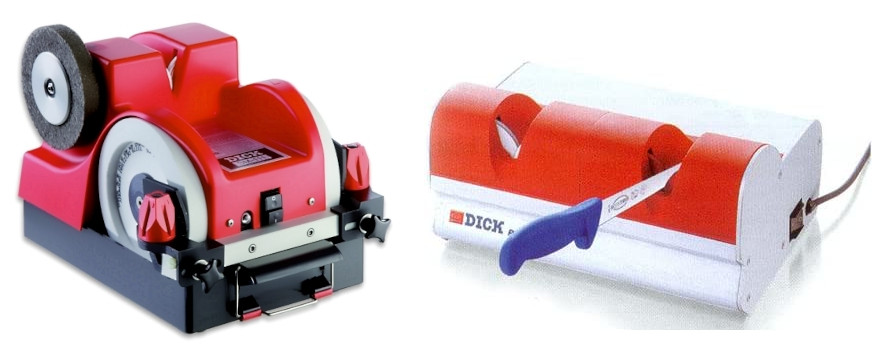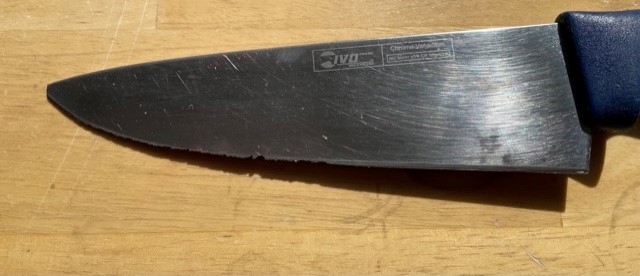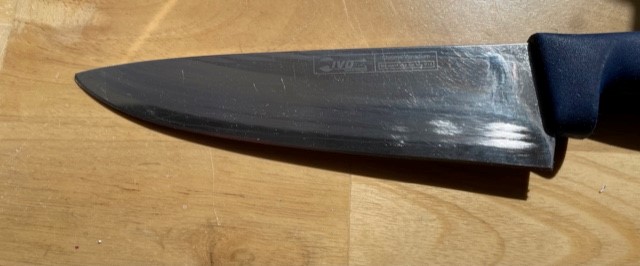Professional Knife Sharpening in Victoria BC

Looking for Victoria’s professional knife sharpening service? We use the best knife sharpening system to ensure your blades slice through tomatoes like a hot knife through butter.
The knife service is drop off and pick up to us. Knives are usually done same day depending on workload.
Scissor Sharpening | Clipper Blade Sharpening | Kitchen Knife Sharpening | Clipper Blade Repair & Dryer Repair
Sharpening Services Menu
Kitchen Knives
We now offer straight blade kitchen knife sharpening using a machine from DICK. The machine grinds and hones the blades to a razor sharp edge. It will have you slicing tomatoes again in no time!
-
Large kitchen knife: 9” up $15
-
Medium kitchen knife: Up to 9” $10
-
Small kitchen knife: under 5” $7
- Edge restoration an extra $5
PLEASE NOTE: There may be additional charges associated with fixing other sharpeners mistakes.
Before Sharpening:

After Sharpening:

FAQ
What are the benefits of using a sharp knife?
Using a sharp knife decreases your risk of injury during use while allowing for high precision cuts and increased focus.
When working with a dull knife, various parts of your upper body are strained while increasing your risk of injury. Using a dull knife strains your wrists, and can lead to fatigue in your arm. Long term use of a dull knife may lead to pain in your shoulders, neck, and wrists.
How to choose the best kitchen knife?
The optimal length for a kitchen knife is 8 inches. The edge of the knife should form a small “V”. If the edge of the knife is rounded, it has lost its edge and should either be sharpened or replaced.
How to clean a kitchen knife?
Kitchen knives should be cleaned by hand using a kitchen cloth or soft sponge with gentle dishwashing soap and hot water.
Avoid placing kitchen knives in the sink or dishwasher as the combination of harsh soap chemicals, heat, and steam dull the knives and shorten their lifespans.
How to use a kitchen knife?
Before each use, it is important to use a steel sharpening rod to reduce burrs on the knife, creating the perfect edge for precision cutting.
Avoid using the sliding the sharp end of the blade along the cutting board to push food as this dulls the edge significantly faster.
Slim flex blades: Best for boning protein while full flex blades are best for cutting fish.
Bow knives: The first 3 inches of the blade should be used to cut meat and the last 3 inches should be used for chopping fruits and vegetables.
Straight edge knives: Best suited to chopping.
What is the difference between a forged knife and a stamped knife?
Forged knives are heavier, higher quality knives formed from heated steel, tempered and then cut down to form their shape. Stamped knives are lighter, lower quality knives which are stamped from a large sheet or piece of metal.
Forged knives take longer to produce (250 pieces produced per week) and have a large spine. Most forged knives have a bolster and are heavy.
Stamped knives are fast to produce (1,000 pieces produced per week) and have a thin spine, making it optimal for chopping while decreasing user fatigue.
A full tang knife is solid.
Knife Sharpening Reviews
Took some knives to Victoria Sharpening and they did a great job of getting an edge on the knives. They worked way better after their sharpening.
~ Helen DoughertyFive Stars!
~ The Will HerdGreat local blade sharpening business.
~Heather Patton


